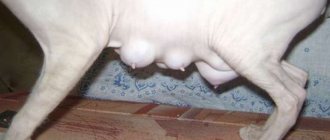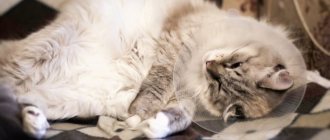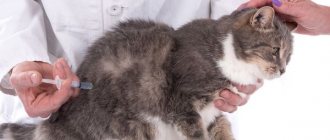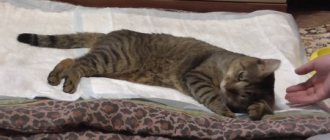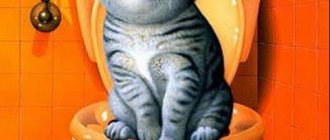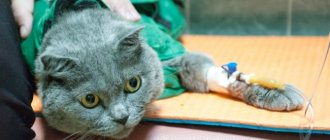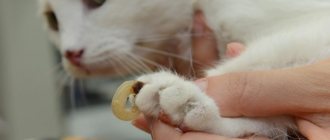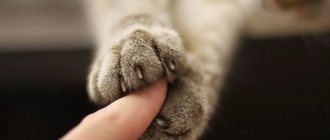6673Pavel
When owners notice that a cat has a bump on the withers, a variety of thoughts arise in their heads. In this situation, the first thing you should remember is whether your pet has recently been vaccinated.
A reaction in the form of bumps at the injection site after vaccination is a common occurrence in cats and dogs, and it does not matter how old the animal is: a year or ten. Read about the options for this complication, as well as other causes of a tumor on the withers of a cat, in this article.
© shutterstock
Is vaccination necessary?
Pets practically become members of the family. It is important that they maintain their health. However, there is always a risk of contracting dangerous diseases. Vaccinating your cat is a reliable and time-tested means of eliminating this risk.
However, in this case, temporary complications can sometimes occur. Vaccination is the infection of an animal with weakened pathogens, which it can easily cope with and develop immunity to this disease. This procedure protects not only the pet, but also its owner from serious dangers.
ATTENTION! If a cat experiences temporary complications, the caring owner is obliged to do everything possible to alleviate his suffering.
Sometimes it seems that by following a certain regime for a cat, you can guarantee the absence of infection. However, in reality it is impossible to completely avoid this danger. Even keeping a cat in an apartment does not guarantee its safety. Pathogenic microorganisms can be brought into the home, for example, on shoes.
Vaccination is necessary for the following reasons:
- Rabies is a deadly disease. Vaccination protects against it. But if this is not done, the animal may become infected and die.
- A sick pet becomes dangerous to other animals.
- A cat with rabies can infect humans with this deadly disease.
After the vaccination procedure, the risk of contracting an animal with rabies is completely eliminated.
Vaccines: when should a cat be given?
Vaccination is an important part of caring for your pet.
Vaccinations help strengthen the animal’s immunity, as well as protect it and the owner from serious diseases that can lead to the death of the furry pet.
Vaccination is also necessary before traveling and traveling, visiting exhibitions and shows where contact with other pets is possible. Vaccinations will also be required before mating to ensure the birth of healthy and active kittens. Animals, just like people, have a vaccination schedule, which every owner who wants the animal to be healthy is obliged to follow.
How is it carried out?
In order to protect a cat from rabies, the first vaccination is carried out at the age of 12 weeks or a little later. As a result, the animal develops immunity that lasts for one year. To ensure reliable protection against rabies, vaccination is required annually.
It is recommended to reuse the vaccine from the same manufacturer. It is important to pay attention to how the pet tolerates the procedure . If it responds well to the vaccine from this particular manufacturer, then it makes sense to use it regularly. In the event that problems arise with vaccinations, it makes sense to consult a veterinarian about using another option.
After the injection, quarantine occurs for 14 days. During this period, the animal develops immunity. At this time, it is necessary to ensure that your pet appears on the street as little as possible and has contact with other animals. During the time when immunity is developed, the cat’s body is weakened and very vulnerable.
ATTENTION! If the procedure is performed in a veterinary clinic, this reduces the risk of adverse effects.
It is not recommended to leave immediately after the injection. It is better to wait 20 minutes to check for an allergic reaction. In this case, specialist help can be obtained immediately.
Diagnostics
Responsible cat owners who discover wen or other growths on the back or other part of the body of their pet quickly go to the veterinarian. Diagnostics is carried out comprehensively and therefore gives the most accurate result.
- First, the doctor will examine the cat, the size and color of the formations, and determine their density and pain.
- Then an x-ray or ultrasound may be prescribed.
- Cytological and histological examination is important. Skin particles are taken from the cat in the area of the tumor. A biopsy in such cases is mandatory.
More conventional tests are also performed - blood and urine. Each type of diagnosis is important; the results of all complement each other and allow an accurate diagnosis to be made.
- To begin, the veterinarian visually examines the pet and palpates the sore area.
- Then ultrasound and radiography are performed.
- To conduct a thorough cytological and histological examination, it is necessary to take pieces of tumor tissue - a biopsy.
- In addition, blood and urine are collected for additional laboratory testing.
In addition, the veterinarian will refer the animal for blood and urine donation.
- Wen usually does not cause symptoms, but requires professional intervention due to the risk of developing into liposarcoma. This is a malignant tumor and can lead to death for your pet.
- Benign formations also do not manifest themselves in any way.
- Abscesses formed as a result of bites, scratches, and scratching are accompanied by severe itching and possible hyperthermia.
- Allergic reactions, in addition to constant itching, are characterized by possible vomiting due to intoxication.
Types of complications
After vaccination, your pet often experiences temporary complications. They can be expressed as follows:
- an allergic reaction to the injection . It can be expressed, in particular, in the form of swelling, redness, and skin rashes. In such cases, an antihistamine is additionally administered. In extremely severe cases, anaphylactic shock may occur.
- may appear under the skin at the withers in the form of a small bump. The reason may be unprofessional administration of the vaccine or the individual characteristics of the animal’s body.
- Reduced immunity during the quarantine period increases the likelihood of other diseases or the appearance of worms.
- Sometimes vaccination can contribute to the manifestations of kidney failure. This is due to the fact that the vaccine is made from cat kidney cells. Once in the body, it can cause the formation of antibodies that act on this organ. The main cause of this complication is too frequent vaccination.
When a pet suffers during vaccination, a loving owner is obliged to do everything possible to support the animal and alleviate its suffering.
Other reasons
A lump on the back, thigh, or withers of a cat after vaccination is formed due to the following reasons not related to inflammation:
- allergic response or intolerance to some substances in a vaccine or medicine;
- incorrect injection (use of a short or blunt needle, incorrect choice of injection site);
- characteristics of the body (breed, age, anthropometric parameters);
- administration of the vaccine by the owner in the absence of veterinary education.
In these situations, the swelling may gradually increase, causing redness, including the surrounding area.
If there is a lump
One of the possible complications after vaccination is the formation of a lump at the injection site. First of all, it is important to determine the cause of what happened. If you contact a specialist, he will conduct a thorough analysis, determine the diagnosis and offer appropriate treatment.
Typically, the following means can be used for this:
- taking medications;
- use of compresses;
- in rare cases, surgery may be required.
Usually this problem is solved in no more than a week.
What does the appearance of a seal mean?
A caring owner should think about how to protect their pet from the danger of contracting rabies. However, sometimes after an injection a subcutaneous lump may appear, which causes concern about the cat’s health.
The appearance of a lump cannot be a reason for panic. This reaction to an injection is possible for several reasons:
- if the animal has an allergic reaction to the administered drug;
- when using a low-quality vaccine.
In most cases, the lump under the skin goes away without the need to take any measures . In a week, no trace of her will be visible. Usually, after an injection, the solution concentrates in one place, and within a few days it disperses throughout the body. The easiest way to take care of an animal in this situation is to help this process.
This can be done by applying a compress to the injection site (on the back of the neck or between the shoulder blades). To do this, take gauze, fold it in several layers and moisten it in an alcohol solution. The compress is applied to the area of compaction for 10 minutes. The procedure must be repeated twice during the day. After its completion, the sore spot is carefully wiped.
IMPORTANT! If the animal tends to scratch the injection site, the use of antihistamines to reduce itching may help.
However, in rare cases, the appearance of a lump indicates more serious things:
- The appearance of a purulent abscess . The inflammatory process occurs as a result of the penetration of pathogenic microorganisms into the wound after an injection. In this situation, it is necessary to contact a specialist who will open the abscess.
- In rare cases, compaction is one of the signs of sarcoma. One of the signs of such a situation is the long time during which it remains with the cat. In this case, palpation does not cause pain, and the seal looks hard to the touch.
The risk of such a disease is associated with the presence of aluminum hydroxide in the composition of the drug. It takes a relatively long time for a tumor to form: from several months to many years. It always appears at the injection site and is characterized by a high growth rate and the presence of clearly palpable boundaries. Only adults are at risk of developing sarcoma. Such tumors almost never occur in a kitten or an old animal.
If a lump occurs, you can wait a few days until it resolves without doing anything . It is advisable to contact a veterinarian, but if there are no warning signs, you can act on your own.
The situation requires the mandatory attention of a specialist in the following cases:
- The lump remains unchanged for a significant period of time.
- In a situation where a wound has formed at the injection site (on the withers or between the shoulder blades), and pus comes out of it.
- An animal's restless behavior after vaccination is a sufficient reason to invite a veterinarian.
- An alarming symptom is the presence of elevated temperature.
- When hair loss occurs.
- If an ulcer forms at the injection site or throughout the body.
When bumps appear after injections, the doctor must decide what to do in the listed cases. A caring owner must monitor the situation and take action in accordance with the cat’s health condition.
Results
The appearance of swelling at the injection sites is common in cats. If the pet’s behavior does not cause concern, there is no discharge from the lump, it is small in size and gradually decreases, then consultation with a specialist is not required. In most cases, this is a normal reaction to the injected solution.
The appearance of a lump between a cat’s shoulder blades is not always detected in time, since for a long time they do not bother the pet. This applies to formations of benign and malignant nature, which are characterized by a long course. Harmless causes can go away on their own within a few days; in some cases, when a lump appears, a mandatory examination by a surgeon is necessary to determine the nature and degree of danger of the formation.
Prevention
In order to minimize the risk of a cat developing a bump after vaccination or other complications, you need to adhere to the following rules:
- In order to get vaccinated, you need to contact a specialist and carry out this procedure in a veterinary clinic.
- When choosing a vaccine, be sure to check its expiration date. If it is not suitable, such a drug cannot be used.
- Although vaccination must be carried out at a certain time, you need to ensure that the animal is not sick at this time and does not have worms.
- When carrying out, it is necessary to remember that immunity exists for a limited period of time. In order for an animal to be safe from rabies infection, it is necessary to vaccinate regularly and do it at a certain time.
- After completing the procedure and during quarantine, you should not wash your pet or expose it to hypothermia.
- It is necessary to plan the procedure in such a way that it is not carried out for kittens during teething, or for adult cats during pregnancy.
After the animal has received the vaccine, it is important to monitor its condition and pay attention to any problems that arise (a wound appeared at the injection site, a lump formed, the cat was vomiting, or others). It is advisable to consult a veterinarian in such situations.
Regular vaccination will protect your pet from the risk of contracting rabies. However, the procedure can sometimes cause complications in the animal. In this case, the owner must take the necessary measures to help his cat.
